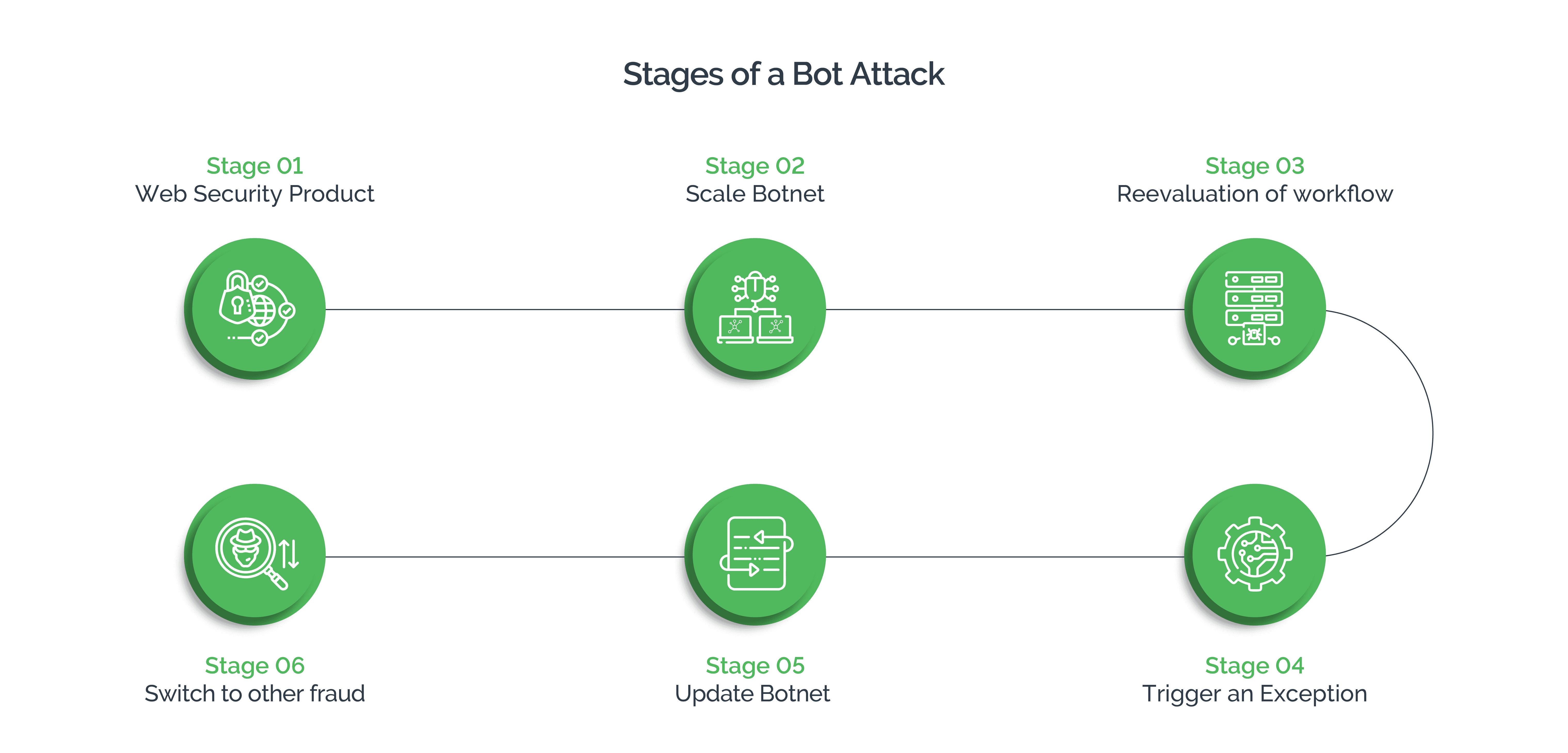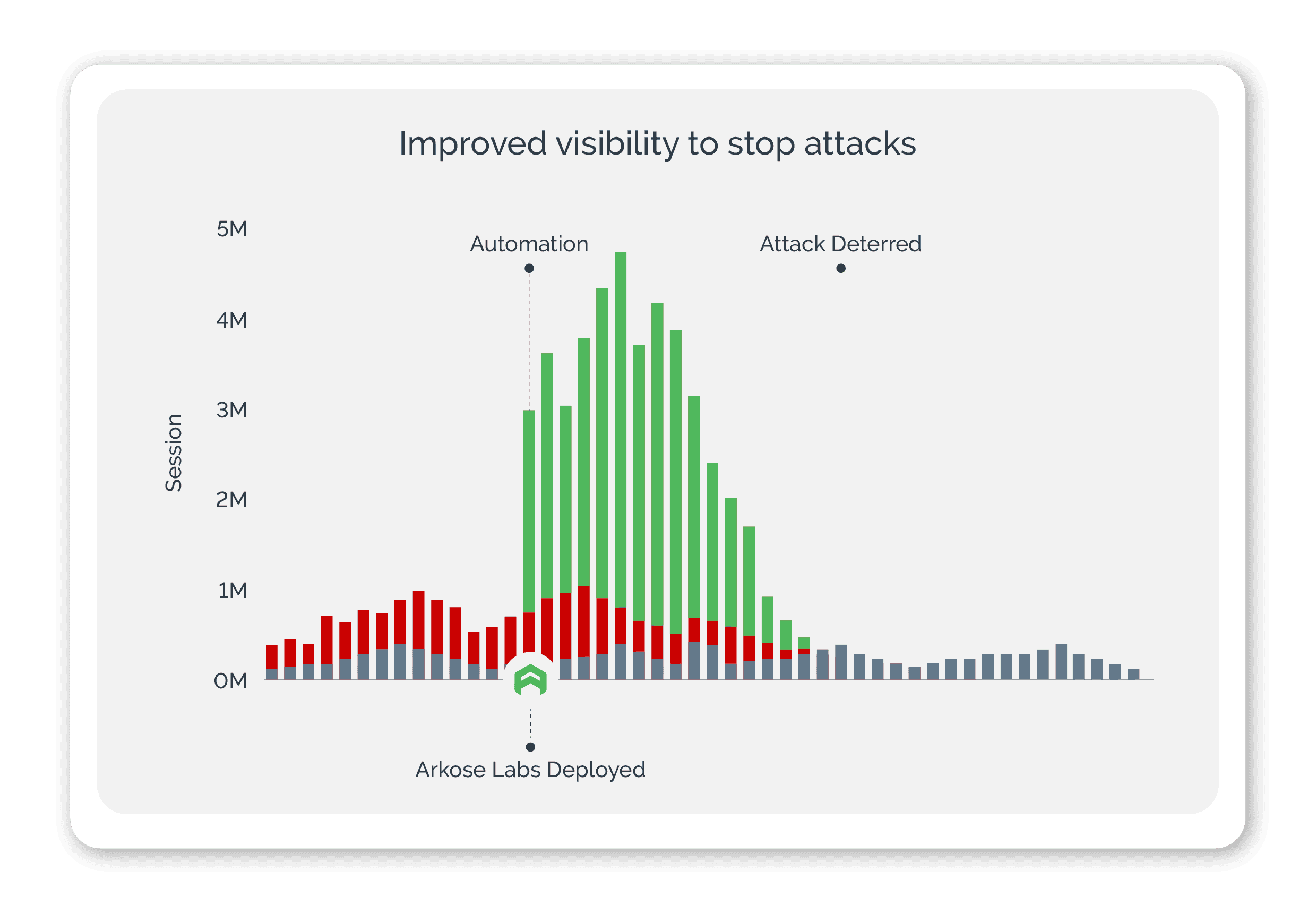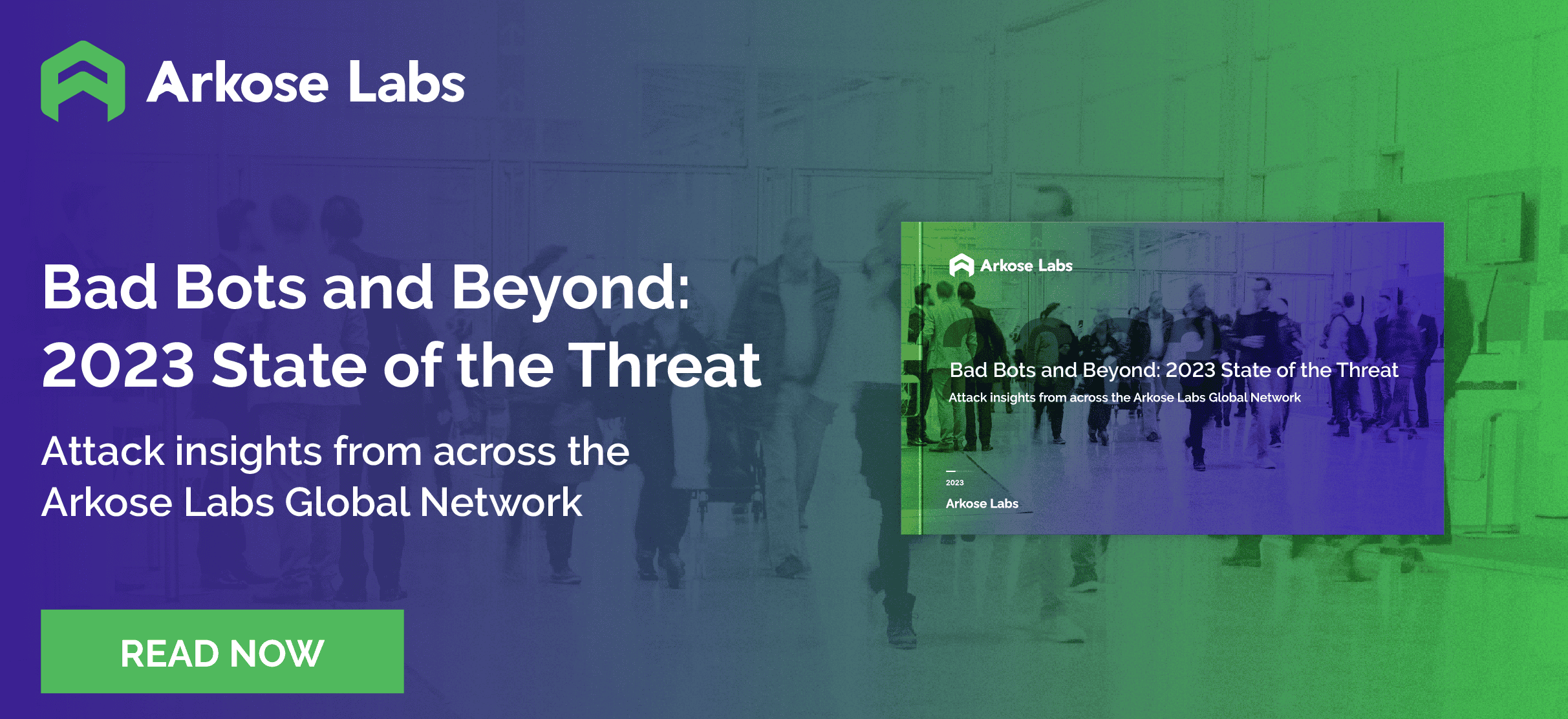Rapid digitization and ever-increasing volumes of online transactions are making digital businesses vulnerable to bot-driven abuse. Attackers use bots to automate complex, targeted attacks to achieve scale. Easily and cheaply available bots, with their speed and the ability to perform around the clock, allow attackers to maximize returns with the least possible investment. To protect websites and mobile apps against a variety of bot-driven attacks, online businesses deploy solutions known as bot protection software, or anti-bot software.
What Is Bot Protection Software?
Bot protection software programs are cybersecurity solutions that specifically fight automated bot attacks to protect digital platforms and services from abuse. Leveraging the latest technologies, such as artificial intelligence (AI), machine learning, behavioral biometrics, and more, bot protection software can accurately identify malicious bot traffic from genuine human users, thereby maintaining the security, integrity, and performance of digital platforms.
The Importance of Bot Protection Software for Businesses
An exponential increase in automated bot attacks, including DDoS attacks, phishing, and credential stuffing, among others, make bot protection software crucial to safeguard business and consumer interests. It acts as a frontline defense mechanism against malicious bots deployed to exploit vulnerabilities in online systems. By preventing malicious bots from causing damage to digital platforms, bot protection helps businesses fuel businesses growth through a safe and secure digital environment for their consumers.
Safeguarding Business Data
Bot protection software prevents malicious bots from accessing, extracting, or manipulating sensitive data. Using advanced machine learning algorithms, behavioral analysis, and other advanced security measures, these solutions enable businesses to ensure security of proprietary business and consumer information from unauthorized access attempts or manipulation. This helps ensure data privacy, regulatory compliance, and overall trustworthiness of their digital platforms.
Preventing Fraudulent Activities
Bot prevention software secures online transactions and protects user account security by detecting and blocking bot-driven account takeover, credential stuffing, and payment fraud. By mitigating fraudulent activities, bot prevention software helps businesses minimize financial losses and reputational damage.
Ensuring Authentic User Interactions
With the ability to distinguish between genuine users and malicious bots, bot protection software ensures authentic user interactions across digital platforms, thereby preserving the integrity of online interactions. Not only can businesses deliver secure and seamless services to consumers, but they also enhance user experience.
How Bot Protection Software Works
Efficient bot management software employs a multilayered approach to accurately identify and mitigate malicious bot activity. Due to its adaptive nature, bot prevention software can thwart new and evolving bot tactics with greater accuracy, often by leveraging the following techniques:
- Behavioral Analysis: To identify deviations from established baseline of normal user behavior, distinguish between legitimate users and automated bot traffic, and trigger alerts for appropriate counter-action.
- Machine Learning Algorithms: To identify patterns and detect anomalies in user behavior by learning from historical data and adapting to evolving bot tactics in real-time.
- Device Fingerprinting: To analyze the unique attributes of devices accessing a platform and identify deviations from expected device profiles, indicative of bot activity.
- CAPTCHAs and Challenges: To differentiate between humans and bots, through user authentication.
- Rate Limiting and IP Blocking: To limit the number of requests from a certain IP address or within a specified timeframe and block suspicious IP addresses.
- Threat Intelligence Integration: To block bots associated with previously identified threats, and stay up-to-date on known malicious IPs and other indicators of abuse.
- API Security: To monitor and secure API endpoints against misuse or automated attacks through continuous inspection and authentication.
- Real-Time Monitoring and Reporting: To help refine security strategies by continuously monitoring user interactions in real-time and creating detailed reports for analysis of bot activities.

Types of Attacks Thwarted
Bot protection software leverages technological advancements for continuous improvement. By employing a combination of techniques, it can deliver superior defense against a diverse range of automated attacks. These programs can adapt to the evolving threats and monitor user activity in real-time monitoring, which makes them vital in securing digital platforms against emerging threats.
Bot protection software uses advanced algorithms, behavioral analysis, and real-time monitoring to identify and mitigate bad bot traffic, detect automated attempts to mimic legitimate user behavior, and prevent unauthorized access. Some common automated attacks protected against include:
DDoS Attacks
Identify and block malicious bot-driven Distributed Denial of Service (DDoS) attacks trying to overwhelm business networks. Robust DDoS protection includes detecting abnormal patterns in internet traffic, implementing rate limiting, and distributing the attack load through content delivery networks (CDNs).
Phishing Attacks
Combat phishing attacks and other online fraud by identifying and blocking automated bots attempting to mimic legitimate user behavior. Detect patterns associated with mass submissions of fake credentials or automated form filling to prevent fraudulent activities.
Brute Force Attacks and Credential Stuffing
Detect patterns of repeated login attempts to protect against brute force attacks and credential stuffing. Implement measures such as CAPTCHAs, rate limiting, and account lockouts to thwart unauthorized, automated login attempts.
Scraper Bots
Stop web scraping activities by preventing content scraping bots from extracting information from websites or APIs. Analyze behavior of requests, monitor for unusual patterns, and enforce rate limits to protect against illegitimate data harvesting.
SMS Toll Fraud
Detect and stop bots from executing SMS toll fraud by providing fake and premium international mobile numbers during account registration, preventing the initiation of unwanted SMS messages.
Spam Bots
Identify and block bots from automating dissemination of spam messages or posting spam content on websites.
Click Fraud
Prevent bots and click farms from generating fraudulent clicks on online advertisements to mitigate click fraud.
Fake Account Creation
Analyze registration patterns and implement CAPTCHAs to prevent automated scripts from creating multiple fake accounts.
API Abuse
Ensure proper authentication to secure API endpoints and protect APIs from automated attacks and misuse.
Account Takeover (ATO) Attacks
Detect abnormal login patterns and implement authentication challenges to thwart automated account takeover attempts.
Noteworthy Features of Bot Mitigation Software
With real-time risk assessment, adaptive defenses, and the capability to block non-human traffic and botnets, bot protection software can help digital platforms fight a wide range of bot-driven attacks. Some noteworthy features:
Real-Time Risk Scoring and Data Enrichment
Ability to continuously evaluate user behavior and assign risk scores in real-time. This dynamic assessment is not only useful in immediate identification of suspicious activities, but also helps enrich data to provide additional context for accurate risk assessment and precision of risk scoring.
Detection of All Automated Threats
Leveraging the latest advancements in technology to fight a broad spectrum of known and emerging automated threats.
Block Invalid Traffic and Botnets
Ability to identify and block invalid traffic generated by automated bots and botnets. Bot protection software can analyze traffic patterns, IP addresses, and user behavior, to accurately identify malicious bots and thwart coordinated attacks orchestrated by malicious botnets.
Adaptive Defenses Against Evolving Threats
Adaptive defenses that help keep pace with evolving bot tactics and techniques. Through continuous learning and updates, bot protection software can quickly adapt to new threats and adjust the defense mechanisms accordingly to ensure future-ready protection against emerging automated threats.
CAPTCHAs and Challenge-Response Mechanisms
Administering CAPTCHAs and challenge-response authentication mechanisms to obstruct and prevent bots from completing automated attacks. These challenges are easy for humans but challenging for bots and automated scripts, thereby enhancing overall security.
Scalability
Scalability to handle increasing volumes of web visitors and user interactions, ensuring that the business is efficiently protected even as the scale of online activities grows.
Key Considerations When Choosing a Bot Protection Software
Efficient bot protection software helps businesses stay ahead of evolving automated threats by balancing robust security and a seamless user experience. To ensure real-time bot detection, ease of integration, and low false positive rates, businesses must consider several factors to choose the solution that best aligns with specific business security needs. Some key considerations include:
- Real-Time Detection: Real-time detection and response to mitigate threats as they emerge. Ability to respond quickly and accurately to prevent potential damage from automated attacks.
- Adaptability: Adaptive defenses and robust machine learning capabilities. Ability to continuously learn from evolving threats and adjust defense strategies accordingly to stay ahead of intelligent bots.
- Coverage: Comprehensive coverage against various automated threats, including DDoS attacks, phishing, credential stuffing, and API abuse. Ability to address a wide range of attack vectors to provide holistic protection.
- Integration: Easy and seamless integration with existing infrastructure, web applications, and content CDNs. Ability to reduce deployment complexities and facilitate a smooth implementation process.
- Scalability: Handle increasing volumes of web traffic and user interactions. Ability to accommodate growth without compromising security or performance.
- Balance: Balance strong authentication measures with user experience. Ability to reduce false positives, where real customers are mistakenly blocked.

Evaluating Your Bot Protection Software
To fight new and emerging automated threats, businesses need up-to-date solutions. Therefore, businesses must regularly evaluate the solution on a number of parameters. Some of the important parameters for evaluation include:
Efficacy
Assess the efficacy of bot protection software by evaluating its performance on detection accuracy, response time, and false positive rates. This will help ensure effective identification and mitigation of automated threats. Some factors that organizations should also consider are:
- Performance Metrics: Evaluate the software's performance for detection accuracy, response time, and resource utilization. An effective solution accurately identifies and mitigates threats while minimizing impact on system resources.
- Incident Response and Reporting: Assess the incident response capabilities and reporting features. The software should provide detailed insights into detected threats, help administrators gain insights into the nature of attacks and take appropriate countermeasures.
- Configuration and Policy Management: Evaluate the flexibility to configure security policies in alignment with specific business needs to ensure quick adaptability to emerging threats.
- Integration with Security Ecosystem: Determine how well the solution integrates with the broader security ecosystem. Compatibility with existing security apparatus can enhance the overall effectiveness of cybersecurity infrastructure.
Cost and Value
Understand the cost and value of bot protection software by assessing the total cost of ownership, return on investment (ROI) and the value that the solution brings. Here is an overview of the parameters that can help understand the cost and value proposition:
- Total Cost of Ownership (TCO): Consider factors such as upfront expenses, licensing, maintenance, and potential hidden costs. A comprehensive evaluation of TCO will provide a clear picture of the total investments required in the long-term.
- ROI and Value Proposition: Consider the value that the bot protection software offers in terms of reduction in potential losses from cyber threats and the improvement in overall security posture.
- Licensing Models and Flexibility: Evaluate the licensing models and options offered by the bot protection vendor to align with the security budget and gain insights into the software’s ability to scale.
- Scalability and Future-Proofing: Evaluate adaptability to new threats and technologies, as well as scalability to meet the evolving needs of the organization, for insights into long-term value.
- Vendor Reputation and Support: Assess the support provided by the bot protection software vendor in terms of responsiveness, improvements to the solutions, and customer reviews.
Implementing Bot Protection Software
Implementing bot protection software depends on unique business needs and risk appetite. There are several factors such as on-premises, cloud-based, or hybrid solutions, ensuring seamless integration with existing systems that can inform implementation decisioning. Here’s a look into the factors that organizations must consider:
Deployment Options
The choice of deployment option is dependent on organizational preferences, existing infrastructure, scalability requirements, risk thresholds, and the need for control over security policies. Organizations must choose a deployment strategy that aligns with their specific IT environment and business goals.
There are several implementation options that organizations may choose from. These include:
- Cloud-Based Deployment: Hosts the bot protection solution on the provider's infrastructure. Offers scalability, flexibility, and rapid implementation. Allows quick adjustments in response to changing traffic patterns and evolving threats. Suitable for organizations with dynamic workloads.
- On-Premises Deployment: Installs and manages the software within the organization's own infrastructure. Offers greater control over security policies and data. Suitable for organizations with specific compliance requirements and the need for maximum control over the security environment.
- Hybrid Deployment: Combines elements of both cloud-based and on-premises solutions. Offers a balance between flexibility and control. Suitable for organizations seeking to leverage the scalability of the cloud while maintaining specific security functions on-premises.
- Proxy-Based Deployment: Deploys the solution as a proxy. Intercepts and filters traffic before it reaches the application servers. Enables centralized monitoring and control, for easier implementation of security policies across applications and services.
- Content Delivery Network (CDN) Integration: Deploys bot protection as part of the CDN infrastructure. Helps distribute bot protection closer to end-users, reduces latency and improves performance, especially for applications with global users.
Training and Support Services
Training and support services are crucial components during implementation. Businesses that invest in training and support services stand to gain not only through successful deployment of the software, but also maintain a high level of security efficacy in the long-run. Training enables the employees to adapt to the changing threats, optimize security policies, and maximize the value derived from the implemented solution. Some of the benefits of investing in training and support services include:
- Effective Utilization of Features: Facilitates full understanding into the features and capabilities of the bot protection software. Enables security teams to effectively configure, manage, and optimize the solution to maximize the benefits.
- Optimizing Security Policies: Allows security teams to adapt to evolving threat landscapes, configure and fine-tune security policies according to the organization's specific requirements, understand the nuances of the software, optimize settings, and strike the right balance between security and user experience.
- Quick Response to Threats: Equips security teams with the ability to interpret alerts and respond swiftly to potential threats. Enables employees to efficiently analyze and prioritize security incidents, thereby reducing response times, and minimizing the impact of bot-related incidents.
- Maximizing ROI: Maximizes the return on investment. Security teams can use the knowledge to leverage the full potential of the solution, thus improving overall effectiveness in fighting automated threats.
- Ongoing Support and Troubleshooting: Enables support staff to resolve issues, address technical challenges, troubleshoot problems, implement updates, and navigate any unexpected issues to ensure continuous operation.
- Adaptation: Keeps security teams informed about emerging threats and evolving attack techniques, informing updates to security strategies and configurations and enhancing the solution’s long-term efficiency.
- Customization: Provides knowledge to support services to help customize the software according to unique business requirements, specific use cases, and industry regulations.
- Knowledge Transfer: Facilitates knowledge transfer within the organization. Reduces dependency on a few individuals. Ensures effective management and maintenance of software even in the event of staff turnover.
Why Partner with Cybersecurity Leader Arkose Labs to Defend against Bots
Arkose Labs is the partner of choice for leading global brands and Fortune 500 companies for comprehensive, advanced bot protection.
With its innovative approach, Arkose Labs offers future-ready protection from a wide range of bot-driven threats. Instead of outright blocking, Arkose Labs offers every incoming user a chance to prove their authenticity. Based on the real-time risk assessment, suspicious sessions are presented with Arkose MatchKey challenges. While good users find these challenges fun and easy to solve, bots and automated scripts fail instantly.
This is because Arkose MatchKey challenges are specifically trained against the most advanced technologies that make them resilient to automatic solvers. High-risk and persistent malicious human users keep facing variations of Arkose MatchKey challenges that keep increasing in volume and complexity. This continuous engagement increases the time, efforts and resources needed to execute the attack and depletes the returns, thus making the attack financially non-viable. In the absence of any economic rewards, attackers are forced to give up for good and move on. This ensures future-ready protection for businesses, without impacting user experience for genuine users.
Arkose Labs combines adaptive risk assessment with the innovative technologies, such as behavioral biometrics, device fingerprinting, machine learning, and artificial intelligence to accurately identify bots and malicious activity in a user-friendly way. With 24x7 SOC support, data-backed actionable insights, raw attributes, and updated threat intelligence from its global network of clients, Arkose Labs ensures businesses are prepared to thwart evolving automated threats with confidence.
Learn more about Arkose Bot Manager.

